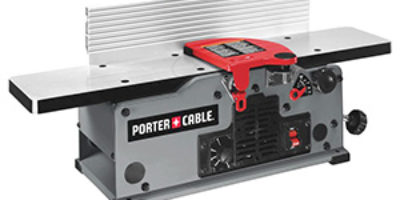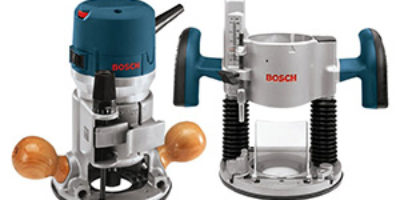We may receive a commission for products purchased through the links on our site at NO additional cost to you.
For making quick, accurate, and clean cuts you want the best circular saw that you can get your hands on. A circular saw is favorite tool to many professionals and DIYers. It’s the go to tool to make a variety of rip cuts and cross cuts at different angles and depths. The popular circular saw now comes in hundreds of models and styles, it can be really confusing as to what to choose. Here we are bringing some of the top circular saw models available on the market today. That have proven to be reliable after a good long period of use. Our circular saw reviews and guides will get into all the details of the top features and uses of this tool of choice.
Best Circular Saw Reviews – The Top Ten
[go_pricing id=”best_circular_saws1″]Whether you are a pro or a newbie, there is a tool for everyone. Scroll to see the complete list of the 10 top rated circular saws, our brief reviews, comparison tables, and detailed guide.
1. Skil 5280-01 Circular Saw
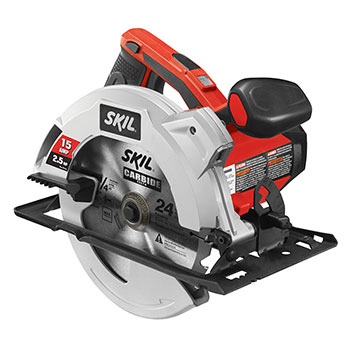
The Skil 5280-01 is number one circular saw in our list. There is a certain mixture in circular saws produced by Skil tools that makes them stand out, it’s quality, reliability, and affordability.
This corded circular saw packs more than enough power for high speed cuts. It uses a 15 amp motor that allows it to operate at 5,300 RPM. Maximum performance is to be expected. The 7-1/4 inch blade diameter delivers up to 2-7/16 inch cutting depth at 90 degrees.
Features a wide foot plate for added stability when cutting. A guarded power trigger with light indicator. An easy accessible rear view depth adjustment. And, a dust blower to keep your cutting line clear.
It offers easy spindle lock blade changes and has the wrench stored on tool. Additionally, it comes with a carbide blade (24 tooth) and a soft carrying case.
Pros:
- A 2.5 horsepower motor produces a high cutting speed of 5,300 RPM. Delivering adequate power to the 7-1/4 inch blade.
- It weighs only 6.95 pounds. That is at least 15% lighter than most other models. Skil has developed an ultra lightweight circular saw that can operate under heavy use with reliability.
- A good bevel capacity of up to 51 degrees with a bevel stop at 45 degrees. This is a fair amount that will leave you with tons of cutting options.
- The Skil 5280-01 comes with a laser guide. This can increase your cutting accuracy immensely.
- The anti-snag guard on the lower portion of the saw is an extra safety feature that also increases the stability of your cuts.
Cons:
- Depth adjustment lever is made out of soft metal, it’s weak and hard to use.
- Poor quality control during manufacturing, in some cases, the laser beam was out of focus.
2. DeWalt DWE575SB Circular Saw
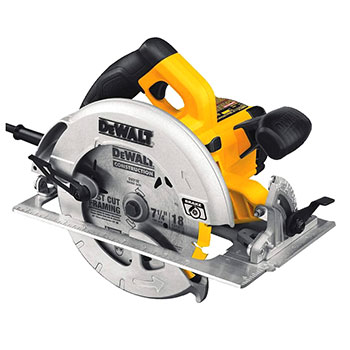
Next up is the DeWalt DWE575SB, a fine 7-1/4 inch direct drive circular saw. It boasts a lightweight design, a powerful motor, and an electric brake. It’s packed with useful features and safety attributes.
Equipped with a 15 amp motor that brings the speed to 5,200 RPM to the proverbial table. While not an especially high amount, it is plenty for day to day use.
The DWE575SB offers 57 degree bevel capacity with positive stops at 22.5 and 45 degrees. The range of possible cuts is impressive. Not to mention, it has a front dust blower to make all these cuts with better visibility.
It also comes with a heavy-duty power cord, DeWalt’s own ToughCord system, increasing the cord durability significantly. On-tool wrench storage and has a contractor carrying bag, so you can pack your saw and all the accessories to your job site.
Pros:
- Top of it’s class with a grand capacity of 2-9/16 inch depth of cut. That’s more than most other models on the market.
- Easy accessible depth of cut adjustment lever.
- An electric brake which is an added safety features that stops the blade within seconds after the trigger is released.
- Also, a lower blade guard to give better performance in beveled cuts. Stamped with a high grade aluminum shoe to provide more accurate cuts.
- Weighing in at just 8.8 pounds, the DWE575SB is a good lightweight option for day to day use.
Cons:
- The lightweight design makes it vibrate at times.
- In some cases, the foot plate was not aligned accurately which makes it hard to ensure a straight cut.
3. Milwaukee M18 2630-20 18 Circular Saw
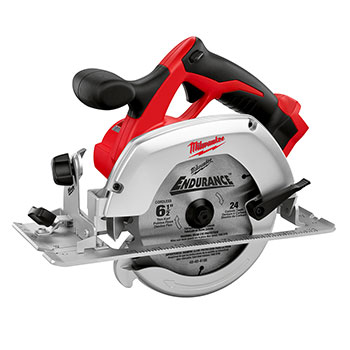
For a brand that has existed since 1924, Milwaukee has continued to innovate the power tool landscape. Their designs are forward thinking and the M18 is a clear example of that.
This 18 volt cordless circular saw spins at a speed of 3,500 RPM. While this may seem like it isn’t enough, however, it brings adequate power to maintain it’s 6-1/2 inch cutting blade. In fact, it has enough power to cut through common 2×4, 2×6, and 2×8 inch boards.
Offers a front bevel and depth adjustment system allowing you to set the bevel up to 45 degrees and adjust the depth of cut up to 1-1/5 inch. It’s designed for a variety of applications, from plumping and electrical to carpentry and framing.
It comes with a two step power trigger for added safety, an Allen wrench mounted on the handle, and a 24T carbide-tipped cutting blade to get you started.
Pros:
- The durability of the M18 is a key selling point. It features a heavy duty aluminum shoe and magnesium guards for the top and bottom of the blade. This means that it can handle drops and more aggressive work.
- Armed by an electronic brake, boosting user safety by having a quick stop blade system.
- A cordless lightweight design, weighs 8.5 pounds. Equipped with a comfortable rubber grip, long working sessions are no problem even with the battery installed.
- A battery display to show the remaining run-time. Also, it is compatible with all Milwaukee’s M18 18 volt lithium ion battery collection.
- Has a five fear limited warranty which only shows the trust they have in their product.
Cons:
- Jams easily under heavy work with a limited battery life (battery not included).
- Also, there is no dust blowing system with this saw.
4. TackLife PES01A Corded Circular Saw
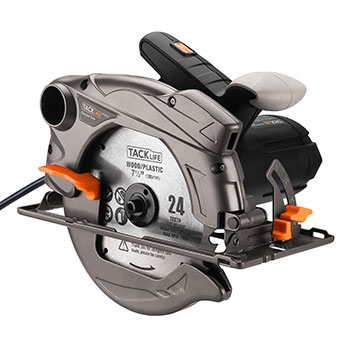
TackLife may not be as popular or as highly regarded as say, DeWalt or Skil, but their line of power tools is great for an introduction into woodworking. The TackLife Classic PES01A features a powerful pure copper motor, two swappable blades, a laser guide, a scale ruler, and much more.
The included blades are 7-1/2 inch and 7-1/4 inch, they are made for different applications. The 24T is used for your common wood cuts, while the 40T is for tile, plywood, and soft metals. Leading you to an unlimited working possibilities.
There should be no tool without a dust collection and the TackLife integrated dust blower works great in keeping your line of cut clear of any sawdust. In addition, the anti-slip handle keeps you in great control with a comfortable grip.
It also has a double power switch design prevents harm by requiring two fingers to use. Thus, accidental cuts are less likely.
Pros:
- The 12.5 amp motor runs at 4,500 RPM. It’s capable of cutting through most materials without hiccups.
- Maximum cutting depth at 90 degrees is 2-1/2 inches. Bevel capacity at 45 degrees is precisely 1-4/5 inches. This is a solid range and capacity that will ensure versatility.
- The laser guide and scale ruler are nice features that help with accuracy.
- Also, features an aluminum guard and iron shoe. The guard will let your tool last longer and the shoe extends it’s use to keep your cuts straight.
Cons:
- Not the best built quality, the bevel adjustment is weak and can be easily bent.
- The laser beam is also off line.
5. Makita SP6000J1 Plunge Circular Saw
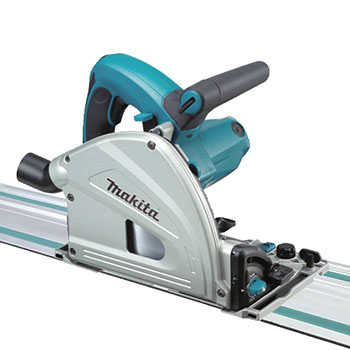
Like most manufacturers, Makita has been producing innovative power tools for years. They tend to deliver great quality products at affordable prices. Their SP6000J1 plunge circular saw is no exception. It offers plenty of features making it a viable option for the professional and the hobbyist alike.
For starters, it comes with a 12 amp motor. This grants plenty of cutting power, making even some of those tougher materials no problem. Cutting speed is variable with a range of 2,000 to 5,200 RPM. For most cases this is more than enough power.
The 6-1/2 inch blade gives a fantastic cutting capacity. It can work with 2-3/16 inch at 90 degrees and 1-9/16 inch at 45 degrees. This provides flexibility that is often needed with a circular saw.
This track saw offers easy plunge release lever, easy depth adjustment scale, a soft start for smooth startups, and electronic constant speed control. Great performance capabilities.
Pros:
- Has a high bevel capacity, from -1 to 48 degrees with positive stops at 22.5 and 45 degrees. This is key for having a broad range of versatility.
- Having the variable speed selection only adds to it’s versatility.
- Built-in torque limiter to protect the motor from overload. Coupled with the electric brake, safety ranks high with Makita.
- High degree of accuracy is achieved with the optional 55 inch guard rail.
Cons:
- Difficult to get good cuts with narrow materials.
- A track saw with a wobbly guide rail, it rocks back and forth in the track making it hard to achieve precise straight cuts.
6. Porter Cable PCE300 Direct Drive Circular Saw
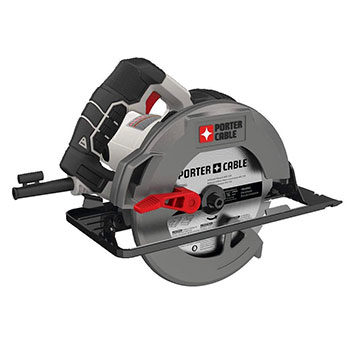
Next we have the Porter-Cable PCE300. This right blade sidewinder circular saw gets the job done effortlessly. Suitable for many applications with a heavy duty motor and quality built.
The PCE300 features a 15 amp motor with an excelling speed of 5,500 RPM, that’s impressive! This gives you the ability to work with many applications without resistance.
It offers a depth of cut at 90 degrees of 2-1/2 inch and at 45 degrees cuts 1-7/8 inch. Depth adjustment is also easy, thanks to the smart design. The spindle lock depth is up to 45 degrees bevel. Giving you a good range of power, speed, and capacity.
Weighs 9.5 pounds, thus, enhancing accuracy and comfort with less vibrations. Line of sight is kept clear due to the overall smart and minimal design of the PCE300. It also comes with a 7-1/4 inch 18T carbide tipped blade.
Pros:
- First, we have to talk about that motor. It is powerful and does not bog down.
- The AUX handle is a comfortable to use, keeping your cuts straight and your vision unimpaired.
- This saw features a steel shoe. Unlike aluminum, it is of higher quality and more durable. It is also strikingly accurate. Cuts glide along like butter on toast.
- Also, the top and bottom metal guards increase the overall durability.
Cons:
- Though quite rare, there was some sudden cessation of power.
- Flimsy steel shoe that doesn’t withstand accidental drops.
7. SkilSaw Southpaw SPT67M8-01 Sidewinder Circular Saw
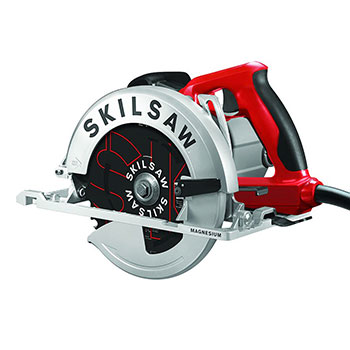
SkilSaw is a brand name more often than not sparks confidence in seasoned buyers. For those looking for a new circular saw, the SkilSaw is a fine choice. The Southpaw circular saw comes with the brand quality behind it.
It packs plenty of features and it is a good choice for both the entry level and the working professional who is looking for a reliable left blade sidewinder circular saw. The left-blade is actually ideal for many situation. It can even improve accuracy of cuts due to a better cut-line visibility available.
The SPT67M8-01 is all durable magnesium parts. The ergonomic and lightweight design couples well with the left side blade. Southpaw’s strength lie in its design, each part works well with each other piece.
Further, it comes with 7-1/4 inch 24-tooth carbide blade, a multi function wrench, and a 10-feet long power cable.
Pros:
- The 15 amp dual field motor provides a solid speed of 5,300 RPM. That’s fine for a wide range of tasks. You’ll have enough torque and power to saw through a range of materials.
- Level adjustment is easy and effective. You have options of 1/4, 1/2, 3/4, and 2x.
- Offers a wide bevel capacity of up to 56 degrees with positive stops and 0 and 45 degrees.
- Suitable for a variety of applications deep depth of cut 2-7/16 inch at 90 degrees and 1-7/8 inch at 45 degrees.
Cons:
- Stock blade could be better, however, it’s a great start. Also, there is no hook or hook mount.
- The base is not perfect flat.
8. Ryobi P506 One+ Cordless Circular Saw
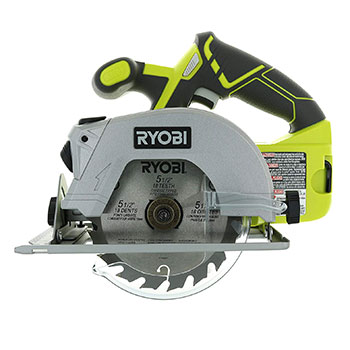
Ryobi tools P506 is a full size circular saw. However, it offers a 5-1/2 inch carbide-tipped blade diameter, suitable for small size projects. The included carbide-tipped blade is solid, it performs well and does not generate too much excess heat.
Thus circular saw boasts an impressive 18 volt battery. This should yield more than enough power for a wide range of uses. You will be hard pressed to find a common situation where this tool size cannot perform.
It’s a left blade setup which works great in many situations. Packing a motor speed of 4,700 RPM, that’s plenty for it’s size. In fact, it is a great speed that does not burn hot or attempt to over do.
At just 2.2 pounds this is an ultra lightweight tool. However, the Ryobi P506 does not come with a battery pack. That is typically sold separately, so factor that in when looking at the final weight.
Pros:
- Offers a fully adjustable bevel from 0 and up to 50 degrees. It’s ready to make cross cuts and rip cuts on a variety of lumber and sheet goods.
- The ergonomic design is something to take note of. The large rubber grip makes handling this tool simple to control no matter the working condition. The weight is also comfortable enough for long sessions.
- Coupled with an awesome cordless design that is compatible with most Ryobi One+ collection. You’ll be able to stick just about any battery on there and get to work.
- Also, the laser guide is a nice bonus feature that helps improve cutting accuracy.
Cons:
- Not suitable for heavy-duty work.
- Blade guard gets stuck easily from saw dust discharge.
9. DeWalt DCS577X1 FlexVolt Worm Drive Circular Saw
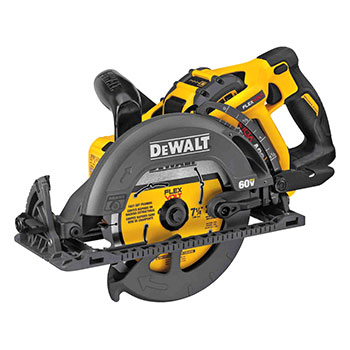
Some of the best circular saws are made by DeWalt. If you are into woodworking you know the name and their iconic yellow design is also not easy to miss. Here we take a look at the DCS577X1, it’s a great circular saw with some common useful features and top-quality performance.
Looking at the motor, you’ll see that the 2,400 max watts give you around 5,800 RPM. This high speed cutting and the extra bump in RPM can save you on many jobs where the extra power is truly needed.
Features a brushless motor that offers longer run-time in cordless designs. A durable magnesium shoe for accurate straight cuts.
Not to mention, there is a rafter hook, an on-tool wrench storage, and an integrated dust blower. All are user-friendly features, backed by great warranty and customer service.
Pros:
- This worm drive circular saw has plenty of power. It does not overheat easily (if ever), and each cut is smooth and accurate.
- The unique FlexVolt series allows you to work with a 20V or a 60V battery. Making it a breeze to use around the worksite. The charger works well enough and the battery gets anywhere from 4 to 5 hours. This may vary but expect it to last the day within reason.
- At 90 degrees straight cuts it offers a 2-7/16 inch cutting depth and at 45 degrees it also offers 1-7/8 inch. Further, the 53 degree bevel capacity is plenty to work with coupled with the 22.5 and 45 degree bevel stops.
- Additionally, it has an electric brake to make sure to stop the spinning blade once you release the trigger.
Cons:
- Blade lock button is too exposed, always handle it carefully.
- Powerful, however, at 10.8 pounds, it’s on the heavy side.
10. Makita 5377MG Hypoid Circular Saw
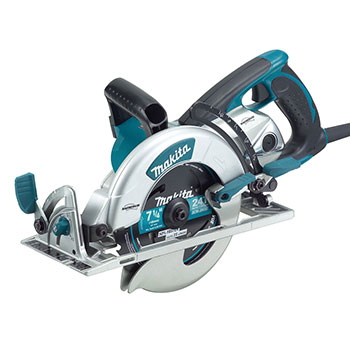
Finally, we have the Makita 5377MG. Being at the bottom of our list doesn’t make it any less. In fact, we only bring the best products. Their main difference lies in the application where each can preform best according to it’s power or capacity.
The 5377MG is a competent and effective circular saw. The build quality and design wise, it is rigorous. Feature-wise, it is packed to the brim, as much as a circular saw can be.
This hypoid circular saw has the ability to outperform with less maintenance. The drives, the sealed gear housing, and the cooling fans, are all features of a high quality machine.
The 5377MG comes with a retractable hook, an on-tool wrench, and a 7-1/4 inch coated framing blade. It includes Makita’s advance tooth design. The teeth are in an “M” shape and have carbide tips. Cutting into even metal is no issue. The coating helps keep the blade and saw from overheating.
Pros:
- A 15 amp motor rendering 2,300 watts of power. Boasting a 4,500 RPM speed making it a great tool for a wide range of applications. The strong hypoid motor with gears made for extensive use. Due to the design, expect more durability, power, and accuracy.
- The ergonomic design of the 5377MG makes it a joy to use. It is well-balanced with durable magnesium components.
- Cutting capacity is 2-3/8 inches at 90 degrees. That’s a large capacity with bevel stops at 22.5, 45, 51.5 degrees. Switching is no issue.
- Also, the guard opens and shuts smoothly. While a seemingly small feature, this is an awesome quality of life improvement.
Cons:
- A heavy tool to use, weighing 13.2 pounds.
- Depth lock is weak and can bend easily. Unfortunately, this problem exist in many circular saw models.
Best Circular Saw Comparison Chart
| Product/Feature | Side | Drive | Electric Brake | Laser Guide | Dust Blower | Dimensions |
|---|---|---|---|---|---|---|
| Skil 5280-01 | Right Blade | Sidewinder | N/A | Available | Available | 10.7 x 15.6 x 7.7 Ins |
| DeWalt DWE575SB | Right Blade | Sidewinder | Available | N/A | Available | 16.2 x 10.1 x 10.5 Ins |
| Milwaukee 2630-20 M18 | Left Blade | Sidewinder | Available | N/A | N/A | 8 x 12.2 x 10 Ins |
| TackLife PES01A | Right Blade | Sidewinder | N/A | Available | Available | 10 x 10.1 x 14.1 Ins |
| Makita SP6000J1 | Right Blade | Sidewinder | N/A | N/A | Available | 16 x 12 x 13 Ins |
| Porter Cable PCE300 | Right Blade | Sidewinder | N/A | N/A | N/A | 14 x 9 x 7 Ins |
| SkilSaw SPT67M8-01 | Left Blade | Sidewinder | N/A | N/A | Available | 12.5 x 9.8 x 9 Ins |
| Ryobi P506 One+ | Left Blade | Sidewinder | N/A | Available | N/A | 12 x 8 x 12 Ins |
| DeWalt DCS577X1 | Left Blade | Worm | Available | N/A | Available | 18 x 9 x 8.2 Ins |
| Makita 5377MG | Left Blade | Hypoid | N/A | N/A | N/A | 21.8 x 11.8 x 12.5 Ins |
Types of Circular Saws
The world of circular saws is vast but also navigable. With the right guide you can find yourself owning a new, solid circular saw in no time. For our purposes, we will look at the types of circular saws mainly used on wood. Woodworking is, after all, what this is all about. Generally, these types differ in motor orientation, weight, torque, and speed.

-
Direct Drive
Also known as a sidewinder, the direct drive is the first option we are looking at here and it is the most common. Direct drive circular saws, usually offer right side blades. This may be beneficial if you are right handed. However, it is not difficult to adapt to a different side. With time, practice, and frequent use you will find yourself using your circular saw with proficiency.
Direct drive motors are usually quite light. Lightweight circular saws have the benefit of being less taxing in energy, thus allowing you to carry them without wearing yourself out too fast. With a sidewinder circular saw, you might be able to get more use in a single session due to the lighter weight, though that is not a rule of thumb nor a fact. Take it with a grain of salt, of course. But we do know that lugging around heavy equipment is not fun. This remains true with circular saws.
-
Worm Drive
Despite the funny name, a worm drive does not involve worms. Not even a little. A worm drive is a typical type of drive in a circular saw, usually, with a left side blade. This drive is made up of a worm and a worm wheel. They are perpendicular pieces, and they provide great power output. These drives advance by a single gear tooth per turn. Their main characteristic is that they have motor positioned at the back of the saw.
This sort of drive has bigger gears than a direct drive or a hypoid drive. This can provide more cutting power and allow more reach. It’s slow spinning capabilities gives high torque and intense cutting power. A worm driven saw likely won’t bog down with heavy use. However, this comes at the cost of weight. A worm drive can be quite heavy. Expect them to add a few pounds to the saw. The weight gain is usually not so bad, but if you want extra lightweight, don’t go for a sidewinder saw
-
Hypoid Drive
The hypoid drive is the third type of circular saw motor. This motor uses a spiraled bevel. The teeth are helical in design, and the operation is a bit different than the worm drive or direct drive saws. This motor is also at the back of the saw with a left side blade, similar to worm drives.
Hypoid drives are great for jobs that need extra torque. Their cutting speed is slow, like the worm drive, but the overall output of power is fantastic. While a worm drive can offer comparable cutting power and performance, the hypoid drive is a viable alternative if you want something different.
Regardless of the drive type, circular saws across the board tend to be reliable little machines. Not one drive type breaks down more than any other, at least as far as we can tell. Always go with what feels best. Choose the saw that works well with your budget and use case.

Choose What Suits You
To answer that question, you have to look at your personal preferences. Those who prefer high torque, slow cutting speed, and lots of power will more than likely choose either a worm drive or hypoid drive circular saw. For the person who wants something more generalized in specialty, the direct drive circular saw may prove most effective.
If you’ve never used a circular saw, we would wholly recommend starting with either a worm drive saw or a direct drive saw. The performance in both will give you the benefits of a circular saw without busting your bank. After all, most brands offer one or multiple types of circular saws to choose from.
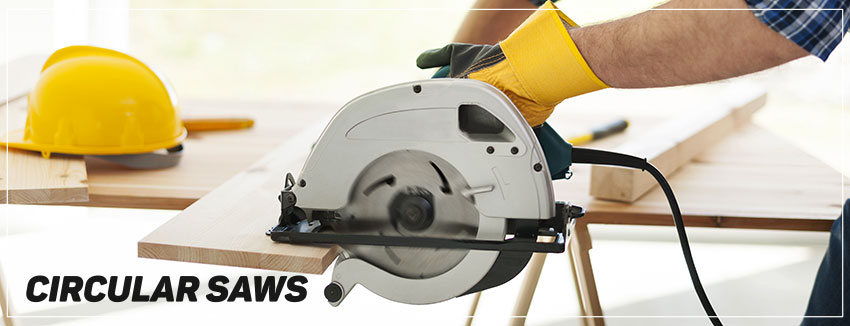
How to Choose the Best Circular Saw (A Complete Guide)
Now that you’re more familiar with the types of circular saws out there and have had a chance to look at our circular saw reviews, let’s dig into the specifics. We will go over the features that we find are most important when choosing a circular saw: power, depth, bevel, blades, shoe type, and much more. Let’s go over them.
-
Power Output
Power spins your circular saw. You want to cut through materials (often wood) without having to do it manually. Average power will depend on if the saw is corded or cordless. Corded saws run on amps while cordless ones use volts. Power output varies on manufacturer and model.
If your work requires heavy cutting, go with a corded circular saw that offers high amperage. You’ll get more cuts done in less time. Perhaps you’re working around the house and power is not such a big deal. In that case, a cordless saw is fine. The volts offered on almost all circular saws will carry you far enough to get your jobs done with ease.
When it comes to run-time on a battery life, some batteries last longer than others and some take longer to recharge than others. Either way, the more powerful your saw is, the faster will the battery drain. Let’s say a battery with at least 4 or 5 amp-hour (Ah) is adequate to light – medium work loads. Remember that there are brushed and brushless motors in power tools. Usually, circular saws with a brushless motors are more powerful, yet, they live longer on a single charge.
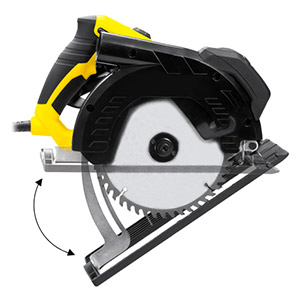
-
Cutting Depth
Circular saw blades vary in size, starting from around 5 ½ inch and up to 12 inch and more. The most common size is the 7 ¼ inch blade. Circular saws of this size allows you to cut through 2 inch lumber at either 90 or 45 degrees in just a single pass. Depending on your angle (45 degrees, 90 degrees) you will get different cutting depths. Some go as deep as 2 ¾ inch while most stay around 2 ¼ inch.
Depth adjustment is also important because you want to be in control of your cuts. A saw that has no adjustment is not a saw to put any faith in. It should be easy to adjust the cutting depth and adjust the cutting angle from a straight 90 degree to a 22.5 or 45 degree bevels.
-
Shoe Plate
A shoe is also known as a foot plate. This is the plate where the saw assembly rest, allowing you to smoothly slide the circular saw across the workpiece. A bent shoe plate can lead to inaccurate cuts. Circular saws usually have either an aluminum or magnesium shoe. An aluminum shoe is more lightweight, however, a magnesium shoe is more durable. If you expect your saw to take lots of abuse, go with one that has a magnesium foot plate.
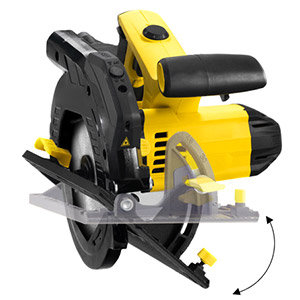
-
Bevel Capacity
The bevel is the sloping surface that allows cuts to be made at a tilt. A good circular saw will have a bevel capacity with a decent range – say, 0 to 50 degrees or so. This allows you to make cuts at different angles. You never know when you will need this feature, either way it is wise to get a saw with a good bevel capacity. Don’t limit yourself.
-
Left Blade or Right Blade
The side where the blade is mounted will vary from model to model. This feature is more of a personal preference than anything. However, there may be benefits to one side versus the other.
A right hand circular saw lets you hold the main handle with right hand and the aux handle with the other. The reverse is true for the left hand circular saw. Right handed people usually go for a right side blade. If you are right handed and using a left handed circular saw, you might notice a better cut line visibility. On the flip side, with a right handed circular saw you will see the cuts drop off to your right, which might be more beneficial depending on the workspace and person working.
Long story short, most people have a dominant hand. Choose the saw that fits into your work style and natural preference. Besides, there are some models that come with a flipping head allowing you to work with one side or the other. Either way, you’ll quickly adjust to whatever you choose. Keep that in mind.
-
Electric Brake
An electric brake is a serious safety feature that we believe is key to a great saw. Without it, you have a risk of the blade spinning even after the power is stopped.
Some estimates put that extra spin time at 12 seconds. That’s 12 seconds of a spinning circular saw blade. Imagine the nightmare that may cause if left unchecked. We’re often focused on work while working (duh), so it is easy to forget that the blade is spinning. One wrong hand placement…you get the picture. The dangers are obvious. A solution is provided with an electric brake.
Simply, an electric brake stops the saw when the trigger is released. Electricity flow is reversed, thus the blade stops spinning almost immediately, in about two seconds. The benefits are obvious. You lower your risk of accidents that may occur after letting off the trigger.
Remember, though, that an electric brake is a safety addition, but you as the operator of any power tool are the sole bearer of responsibility. Take all precautions; don’t rely on the machine to cover the safety, ever.
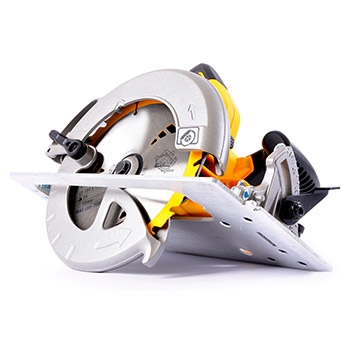
-
Blade Guard
The blade guard is what keeps the blade from being out in the open when the saw is not being used. When the trigger is pulled and the saw is activated, the blade guard shoots up and the cuts are made. When the trigger is released, the guard comes back down. This prominent safety feature is always on the top portion of the blade, however, you should check if it is also employed on the bottom.
Additionally, there are models that have the blade enclosed within the machine, such as the plunge circular saw. This design allows it to work safely with no blade guard. It also gives you the ability to accurately plunge the cutting blade into the material at any point, without having to start the cut only from the edge of the material. This also allows the blade to run along a guide rail to guarantee an accurate cut.
-
Work Light, Laser Guide, Dust Ports
Some circular saws have built-in convenience features. One of those is a work light. A work light activates with the trigger and will help illuminate the cutting area. This can increase productivity if you are in a low-light environment. It also help with safety. You won’t be cutting in the dark or relying on a shoddy flashlight. You’ll have some light in front. Your cuts can be done with confidence this way.
Another convenience feature is the laser guide. The laser guide help in keeping your cuts straight and accurate. Usually found on premium models, a laser guide can make a difference in your work output, though small differences they may be. Every inch counts sometimes.
Dust ports are another thing to consider. These keep the dust from gathering under you and toss the dust aside like the waste it is. Not every saw comes with one. However, you may find attachments depending on the model.
After all, each tool comes with it’s own set of features. However don’t let these little convenience features grab all your attention. First, you should consider the projects that you will be mostly working on so you can decide on the dimensions and the cutting capabilities. Then, consider ease of use and the safety features. Not to mention, the environment where you will be working in so you can decide on whether to go for a corded or a cordless model.
What is a Circular Saw?
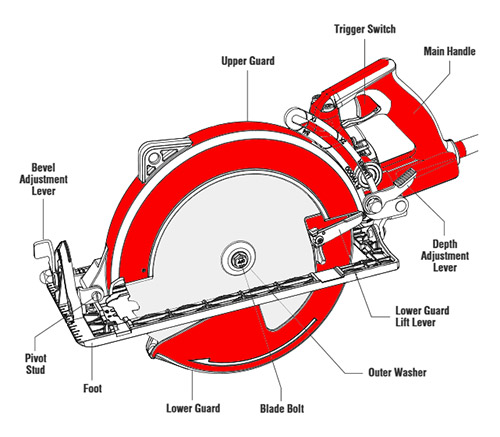
A circular saw is a handheld tool used to make precise, accurate, and consistent cuts. It has a circular, toothed blade that spins at high and slow speeds around an arbor. These blades are replaceable, though they do tend to last some time. Also, the size of the wood you will be able to cut varies.
Circular saws may be handheld or mounted on a table. However, the term circular saw applies specifically to the handheld types, whereas, a mounted type would apply to a table saw or a panel saw. Typically, a circular saw is used to cut wood. There are similar handheld circular saws that focus on bone, metal, masonry, and more.
Circular saws save time when it comes to making repetitive cuts. Due to their accuracy they are great for a wide range of projects. They are also quite powerful – especially considering their handheld size – and they can slice through many types of woods as if they were a hot knife meeting a loaf of bread.
See more – Best miter saws reviewed
Types of Blades
Circular saw blades for all-purpose wood cutting are almost all tungsten carbide tipped blades. Few are made with high speed steel, which are usually used in projects where you would likely encounter high temperatures during operation. There are other characteristics that differentiate a blade from the other. Making each blade more suitable for certain types of projects.
For example, the number of teeth, a blade with fewer teeth makes faster, aggressive cuts. Where a blade with more teeth makes smoother, flush cuts. Also, the kerf, which applies to the width of the blade. A thinner kerf makes less material waste, however, more likely to vibrate easily.
See also – Oscillating Muti-Tool
Corded Circular Saw vs Cordless Circular Saw
As we touched on earlier, there are two ways to power a circular saw; with a power cord or with batteries. There are benefits for both types. However, which works best for you will depend on your situation, workspace, and needs as a craftsman.
Corded Circular Saw
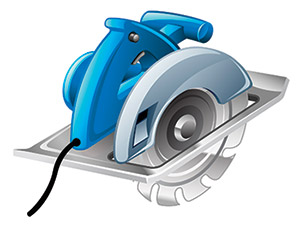
For starters, you will typically get more power out of a corded circular saw. This is because the tool does not rely on a battery. A battery will often give you less power as it is drained. With a corded power cable, on the other hand, you will retain a consistent amount of energy supplied to your circular saw. This may be a necessary feature if your work demands more juice.
The most obvious downside is mobility. A cord will get in your way at some point. This may be the case if you move around while making your cuts. Perhaps you work on a job site that requires your attention in multiple places. A corded circular saw will need to be plugged in and unplugged before moving to a new spot. That is not a huge concern if you work from home. A corded power tool fits nicely into a small workspace that does not get rearranged often.
Another thing to consider is that a corded circular saw can pose a safety concern. Again, this rings true more so if you move around a bunch while you work. Construction sites, handymen, rooftop workers, and more may find themselves assailed by a dastardly power cable. It’s wise to always be aware of where the cable is. Place your movements with caution. A trip can lead to serious injuries or worse!
Cordless Circular Saw
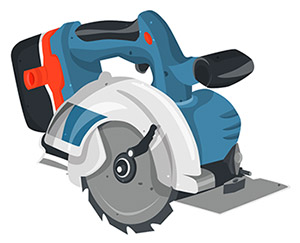
Right off the bat, the obvious advantage to using a cordless circular saw is that it is mobile. Being able to move around and cut when and where you need – without hesitation – is a huge plus. You don’t need to worry about unplugging before moving either. This saves time, energy, and focus. Honestly, this is the biggest bonus to going cordless. The mobility provided can be a godsend in the right situation. However, having no power cable comes with more than a couple of downfalls.
First, there is the question of weight. A battery pack will add more weight to your circular saw. This may not be an issue for everyone, but for some it will be the straw that breaks the camels back. After a long day of hard work, the last thing you might want is to lift that heavy saw again including it’s battery charger. A corded saw will save some weight and thus save some energy.
Then there is power output. On average, a corded saw will be more consistent and more powerful than a cordless one. The difference is not huge, but it can be clear. If you work in long spurts, consider a corded saw. The cordless saw, while efficient enough, will typically get weaker as the battery drains. This can make for some rough cuts!
At the end of the day, it all boils down to what you want and what your job requires. If you want the stability of a corded saw, go for it. Need that mobility? Grab a cordless saw. Either way, you will be pleased with your choice as both are best at one thing: making cuts easier.
Bottom Line
We’ve gone into quite some detail about what are circular saws and how to best look for one. With this little knowledge you are now prepared to find the best circular saw for your situation. Yes, there are loads available. But our guide is available to help narrow down that overwhelming sensation. We focus only on quality from reliable brands. From our circular saw reviews you can grasp which saw suites you best according to the power capability and capacity. Next, you can check other safety features and ease of use features. Remember, that while a laser guide is a nice feature, be sure that a feature such as the dust blower is much more important. We hope we could help. Stay in contact with the us in the comment section below.

